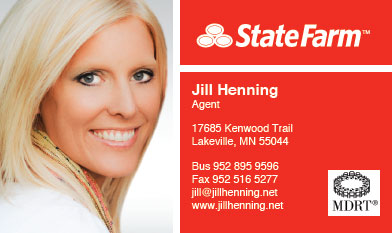Sponsored : Have you thought about your insurance lately? Advise by Jill Henning
Hello!
 I want to introduce myself and my agency! My name is Jill Henning and I own and operate a State Farm Agency in Lakeville, Minnesota. I work with all types of insurance from auto and home insurance to life and disability insurance and everything in-between! My favorite part about my profession is building relationships with my clients and educating them about their insurance and financial services.
I want to introduce myself and my agency! My name is Jill Henning and I own and operate a State Farm Agency in Lakeville, Minnesota. I work with all types of insurance from auto and home insurance to life and disability insurance and everything in-between! My favorite part about my profession is building relationships with my clients and educating them about their insurance and financial services.
I often find that individuals may not know what kind of insurance policy they really have and how comprehensive (or not comprehensive) it is until they have a claim. When clients come to my agency, we help educate them about the different types of policies and coverages. Especially when it comes to homeowners insurance, I find clients sometimes think that they bought a “good” policy and that it will pay out in the event of a claim, but find out later that many things are not covered in full or are excluded altogether. It is extremely important to know what type of policy you are purchasing and how stable and trustworthy the company you are purchasing it from is.
I would like to invite you to engage with me on a question & answer forum about any insurance related questions. To get started on this issue, I thought I would provide you information some of the most frequently asked questions that I receive about auto insurance.
Q: What is “PIP” coverage?
A: The state of Minnesota requires that individuals carry PIP or “Personal Injury Protection” as part of their liability coverage. Minnesota is a “no-fault” state, meaning that if you are injured in a car accident, regardless of who was at fault for the accident, your own policy’s personal injury protection would pay out for your injuries. Once the personal injury limits have been exhausted, if the other driver was at fault, their liability insurance would pay for your additional medical bills. If you were at fault for the accident, your medical insurance would have to pay for costs incurred above the personal injury protection limit. The minimum amount of personal injury protection you can purchase is $20,000. You can purchase higher limits if you would like, in increments of $10,000, to a maximum of $50,000 of coverage. You also have the option to “stack” your personal injury protection. Stacking means that if you have more than one vehicle in your household, you can utilize or “stack” the coverage from all of the vehicles in the household onto one injury claim. For example, if a client has two vehicles in their household, each with the minimum coverage amount of $20,000 per vehicle and the coverage is “stacked,” they would be able to access a total of $40,000 if injured in an accident.
Motorcycles do not have an option for “PIP” so any injury on a motorcycle would need to be covered by either the at-fault individual’s insurance policy, or your medical insurance if you were at fault.
I often hear clients say that if there is an accident in a parking lot, each person pays for their own damage because Minnesota is a “no-fault” state. This is one of the biggest misconceptions I hear from clients about insurance. It is very important to understand that the only place “no-fault” coverage applies is related to injury. If you are involved in any sort of accident, it is extremely important that you get all of the necessary information from the other party to start a claim. This leads me to frequently asked question #2…
Q: What should I do if I have an accident?
A: The most common thing we see with clients when they have an accident is that they do not exchange information with the other party and assume that the information will be obtained by the police report. While the information is contained in a police report, it can take a few days for that report to be filed and available to you, therefore delaying your claim process. You will want to be sure to get the name, phone number, insurance provider, and policy number of the other party. That way when you contact your agent, they will be able to reach out to the other driver, or the other driver’s insurance carrier to start the claim process. Additional things to know when you have an accident:
- Do not admit fault. It is best to remain calm and not discuss details of the accident with anyone but a police officer or the insurance company.
- Understand that police officers do not make the determination of who is at fault for an accident. The only thing they are able to do is take down the details and issue citations if there was a violation made.
- If the other driver is blatantly at fault for the accident (for example, they rear end you) then the claim should be filed under their insurance policy. You do have the choice to file the claim under your own insurance policy and then your company will do what is called “subrogate” the claim in order to be repaid for the damages. The most important thing to understand about the subrogation process is that you will have to pay your deductible have then be reimbursed once the at-fault party’s insurance company pays out. Also, it can be a lengthy process (typically between 3-6 months) to get your deductible back.
Q: When do I pay my deductible?
A: Often times policyholders think that they have to pay a deductible for every claim ever made. However, you actually do not incur a claim unless you are fixing your own vehicle. Damage caused to another person’s property comes from the property damage portion of your liability coverage, which is never subject to a deductible. The same is true about bodily injury to another party…it comes from the liability portion of your policy which is not subject to a deductible.
Q: What happens in the event of a hit & run claim?
A: If you are the unfortunate recipient of a hit & run claim, you will need to file the claim under your own insurance policy’s collision coverage, so you will incur your deductible. That being said, most insurance companies will not count it as an “at-fault” or “surchargable” accident, so there typically is not be a change to your insurance rate because of the claim. You will want to ask your particular company to be sure if their guidelines surcharge you for a hit & run claim or not.
I hope that you have learned something new by reading this article, or at least gained some additional insight about a topic you are already familiar with. To truly make this column applicable to you and as informative as possible, I invite you to reach out with questions you may have on any type of insurance! Reply in the comments section below and I will be happy to respond in my next Q&A. Or if you have a specific question based on your family’s needs, you can reach me at jill@jillhenning.net or on my office line at 952.895.9596. I look forward to helping you any way I can!
Tags: accident, auto and home, disability, hit & run, insurance, Lakeville, life, Minnesota, PIP, policy, sponsored, State Farm, State Farm Angency








